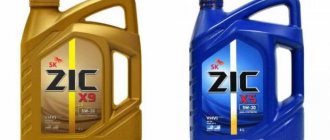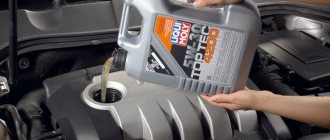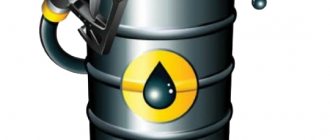Synthetic or semi-synthetic: what's the difference?
Synthetics
First you need to understand: what is synthetics and what is semi-synthetics. Synthetic oil is an artificially synthesized liquid, the basis of which is still organic substances - natural gas or oil. Various technologies are used for manufacturing, which are discussed in a separate article; here I repeat that the resulting lubricant retains its characteristics throughout the entire period of use, is now considered the most advanced type of lubricants, the molecular formula has been improved, and is resistant to oxidation.
Synthetic oil is supplemented with an additive package that improves fuel combustion and engine power. Synthetics retain viscosity over a wide range of temperatures, in cold weather the engine starts easier, and remains stable under overloads. Provides a stable film on parts in any conditions, has high fluidity. But this type of oil has a significant disadvantage - its high cost, which is why it is used mainly only in new engines that are demanding on the quality of lubricant and are simply dear to their owners. As you know, the newer the thing, the more reverently we treat it. But if we talk about compatibility, then synthetics are better suited for new engines.
Important! To put it bluntly, all oils consist of base oils + a package of additives. Essentially, everything is made from a mineral base. But it is in synthetics that there are more of these additives than base oils. Therefore, the composition is more stable than that of semi-synthetics. And we remember that there are different types of synthetics, hydrocracking (when group 3 base oils are used), PAO synthetics and esters. Shell has its own technology for producing base oil from gas.
Semi-synthetics
This is a mixture of an additive package and mineral oil, but there are many times fewer additives and more mineral oil. At the same time, mineral oil bases come in different classes; in synthetics, as a rule, these classes are higher and cleaner. In semi-synthetics you will not find PAO or Esters. The percentage of content of one or another component is not regulated in any way; depending on the manufacturer, it can be 50x40, 70x30, and so on. Semi-synthetics cannot withstand the same severe frosts as pure synthetics; they always contain fewer additives and are more susceptible to oxidation. That is, it represents a kind of golden mean between expensive synthetics and cheap but ineffective mineral water. Thanks to these properties, semi-synthetics are much more popular, especially for used cars or early years of production.
Important! Choosing synthetics or semi-synthetics is your personal choice. Manufacturers usually indicate in the instructions the viscosity according to SAE in the passport. If, for example, you specify 0w-20, it will be synthetic. And if 10w-40 is semi-synthetic, but even in the 10w-40 class there are synthetics, so you can safely pour synthetics into a VAZ if it’s safer and you consider it necessary.
10W-40
These oils are used all over the world. Scope of application – cars of the following types:
- passenger car;
- commercial;
- cargo
They recommend using products with a certain level of viscosity. The material is beneficial where a high mileage engine is installed. What is needed here is a liquid with stable properties, a gentle effect on engine elements, and a low burnout rate.
The advantages include the presence of:
- wide operating temperature range;
- increasing the stability of rubbing surfaces before the appearance of wear and rust;
- easier startup even if the temperature outside is below freezing;
- stable thermal-oxidative ability;
- properties to reduce fuel consumption;
- low soot formation inside diesel engines.
Below are 4 types of oils that you can give preference to.
Mobil Super 2000 X1 10W-40
Average price: 1138 rubles.
The composition has an improved, semi-synthetic formula. It has excellent performance properties relative to previously released models. It was developed in order to prevent: the appearance of deposits, sediment accumulation, and a decrease in the service life of the propulsion system. Excellent thermal and oxidative stability. Control over oil consumption is established. Resistance to low temperatures, which allows you to start the car in cold weather without problems. Suitable for Volvo, Chevrolet, VAZ and more. It is recommended to top up or change every 10,000 km.
Mobil Super 2000 X1 10W-40
Advantages
- versatility;
- excellent technical characteristics;
- resistance to low temperatures.
You will be interested in: TOP 7 best electric bicycles: which one to buy, reviews, characteristics, price, pros and cons
Disadvantages
- high price.
Shell Helix HX7 10W-40
Average price: 1090 rubles.
An excellent option for high-power engines running on diesel in difficult conditions. The special formula allows for quick cold starts, saving fuel, and increasing engine protection.
The manufacturer used a number of different additives, which eliminates contamination of engine elements, prevents corrosion and sediment.
Shell Helix HX7 10W-40
Advantages
- acceleration of internal combustion engine operation;
- the composition contains high-quality additives;
- engine contamination is excluded.
Flaws
- It is possible to purchase a fake.
Esso Ultra
Average price: 1125 rubles.
European quality worthy of respect. The product is included in the TOP 10 of different popularity ratings around the world. The composition contains components that increase protective properties. Affordable price. There are approvals that allow you to use the oil without fear. Filled into gasoline and diesel engines. It does a good job of cleaning the internal cavity from sediment, soot and other contaminants. There are disadvantages. Designed mainly for used cars, low environmental friendliness, viscosity, volatility.
Esso Ultra
Advantages
- versatility;
- there are approvals allowing use;
- formation of sediment is excluded.
Flaws
- used mainly on older car models.
Elf Evolution 700 STI
Average price: 990 rubles.
French oils have always been in demand. They are recognized as favorites among European products. All this is thanks to its special properties. Increased engine wear protection, which ensures prompt fluid supply even in cold weather. In winter, at a temperature of -45, the properties will not change, the viscosity indicators will not drop.
Uniform distribution throughout the engine cavity in any car, regardless of size, power, brand, model, configuration.
Perfect for gasoline and diesel vehicles. The manufacturer recommends flushing the engine before filling with new oil. Motor oil with good cleaning properties.
Elf Evolution 700 STI
Advantages
- good performance properties;
- resistance to low temperatures;
- increased engine protection.
Flaws
- Before each refueling it is worth flushing the engine.
Using such data, you can choose an option for yourself that will satisfy you 100%.
What are the differences and which is better?
The difference is in the molecular composition itself: synthetics have well-thought-out technical characteristics, its molecular formula is special, due to which it becomes resistant to thermal and chemical influences, and the replacement period is extended. Semi-synthetics have a stability higher than mineral water, but less than synthetics, but it is affordable and, in general, performs its functions very well.
What's better? This is a trick question and does not have a simple answer. In terms of technical characteristics, of course, pure synthetics are better. But in general, both types of oil are good: synthetics are ideal for new cars, semi-synthetics for used cars - at what point it’s time to switch to semi-synthetics no one can say for sure, it depends on the engine, its condition and the service life set by the manufacturer. The problem is that in a worn-out internal combustion engine, synthetic oil will begin to burn more, but this does not always happen. In addition, the main role when choosing an oil is not this factor, but the tolerances and specifications of the oil according to international standards; they determine which engines can be filled with a particular lubricant.
My advice! If you have already asked yourself the question of switching from semi-synthetics to synthetics. I advise you to try it, especially in winter this is important. Just fill it up and observe the operation of the engine, the amount of oil used after 1000 miles and a visual assessment of the engine after a mileage of 7000-8000 km. If you notice negative aspects that are unlikely, you can always return to semi-synthetics. Such an experience will not cause damage to the engine.
How to distinguish synthetics from semi-synthetics
You can distinguish one type of oil from another by the inscription on the packaging:
- Semi Synthetic - semi-synthetic formulations containing at least 50% synthetic components.
Synthetic based oils:
- Synthetically Fortified – synthetically fortified with synthetic content up to 30%.
- Synthetic Based – synthetics up to 30%.
- Synthetic Technology – synthetics up to 50%.
Synthetic motor oils are labeled Fully Synthetic .
Important! When purchasing an oil, be sure to read its review and study laboratory tests from independent laboratories. Let’s say synthetics in a “hydrocrack” are always inferior to PAO synthetics, but in a canister these data are often kept silent or exaggerated by adding 5-10% PAO to the composition, proudly declaring PAO synthetics. In general, it is useful to study laboratory tests in order to choose the ideal oil for your car.
Oil labeling
First of all, you need to understand what the symbols on cans of motor oil mean. They indicate its viscosity-temperature properties in accordance with the international standard SAE J300. According to it, all-season oils, which include types 5w30 and 5w40, are designated by two numbers. Let's talk about deciphering oils:
- The first number “5” means that the oil can be used at a minimum temperature of -30°C. In this case, the maximum viscosity for turning will be 6600 mPa s. And the maximum viscosity value for pumpability is 60,000 at a temperature of -35°C. As for high-temperature viscosity, at +100°C its minimum value will be 3.8 mm²/s.
Dependence of kinematic viscosity of oils on temperature
- The number “30” tells us about the viscosity of the oil at high temperatures. In particular, oil with this designation has a minimum viscosity of 9.3 mm²/s, and a maximum viscosity of up to 12.5 mm²/s. The oil is also characterized by such a concept as HTHS - High Temperature High Shear Rate. It determines the shear strength of the oil at high temperatures, that is, the stability of the viscosity characteristics. In particular, for oils with the number “30” in the HTHS marking, the value is 2.9 mPa s at an ambient temperature of +150 ° C, and a shear rate of 1/1000000 second.
- As for the number “40”, its decoding is similar. 5W-40 oil has a high temperature viscosity in the range of 12.5...16.3 mm²/s, and the HTHS value is the same 2.9 mPa s at an ambient temperature of +150 ° C, and a shear rate of 1/1000000 second.
The letter W in the designation of oils means the English word Winter, which translates as winter. That is, oils are considered all-season.
However, the given physical parameters tell little to the average car owner. Let's try to translate these facts into a more understandable language.
Characteristics of motor oils
The physical and chemical analysis of motor oil includes: viscosity index, ash content, alkaline numbers and other indicators. What does this mean? Let's consider the influence of the main technical characteristics on the quality and properties of engine lubrication. Read more
How to correctly switch from synthetics to semi-synthetics
You should not change the oil type only based on mileage. The main criterion by which it is determined that it is time to switch to semi-synthetics is increased oil consumption, this means that the wear of engine parts has reached the point at which the less viscous synthetic begins to burn out and needs to be replaced with oil with a slightly higher viscosity.
Another factor is that synthetics have better cleaning properties, remove dirt that acted as a seal in some gaps, resulting in the formation of cracks and this also affects oil consumption. But, of course, you shouldn’t put all the work on the oil alone; you should also trust the engine; perhaps the cause of the leak is not the lubricant at all.
Advice: The formula is simple - if oil consumption does not increase, fill in synthetic and do not pay attention to any advice. Semi-synthetics will not be able to maintain the internal parts of the internal combustion engine as well as in their original form, as synthetics based on hydrocracking, PAO synthetics and esters do. For winter, synthetics are not replaceable; semi-synthetics are simply not a competitor in severe frosts.
Do I need to flush the engine?
When switching from synthetics to semi-synthetics, it is not necessary to flush the engine, but it is better to reduce the new oil mileage interval by half, and subsequent times you can return to the required interval. But if the transition is made in the opposite direction - from semi-synthetics to synthetics, then flushing should be done more preferably, but again, this is not a critical factor.
Is it possible to mix
A small amount of oil remains in the system during filling, so mixing occurs in any case; if you want to protect your engine, use lubricant from one manufacturer. You should not mix synthetics and semi-synthetics; if this happens, it is better to reduce the service interval (when changing the oil) and replace it as quickly as possible if you just had to add semi-synthetics to synthetics. And I remain of the opinion that for this purpose you need to take the same brand, or at least one that is similar in all tolerances and classifications.
5W40
The car enthusiasts club will tell you that this viscosity category is in demand, provided that the product is made with high quality and is not counterfeit.
It has the following distinctive characteristics:
- Stabilizes the functioning of the engine, cleans its cavity.
- Reduces wear rate.
- Increases protection against thermal oxidation.
- Prevents rust.
- Increases protection against exposure to negative factors.
- Minimal volatility.
- Low consumption.
- Compatible with materials such as seals.
- Possible combination with catalyst type elements.
- Allows you to start the engine at low outside temperatures.
You will be interested in: TOP 8 best torque wrench: rating, which one to choose, how to use, characteristics, reviews, pros and cons
Three types of oil were included in the ranking of the best.
Castrol Edge 5W-40
The average price is 2190 rubles.
Increases the performance and wear resistance of the motor, both modern and old. Created by the best engineers based on innovative materials. Designed for harsh conditions. Can be poured into productive equipment that has high demands.
The composition is made in such a way that it is able to: be used for a long time, suppress the formation of deposits on the walls of the engine, and increase the speed of response to starting.
The product will significantly increase efficiency and protect the engine under various driving conditions, regardless of the outside temperature. Can keep the system in its best condition even with intensive and long-term operation.
Castrol Edge 5W-40
Advantages
- good engine protection;
- resistance to low temperatures;
- improves engine performance.
Flaws
- none.
Total Quartz 9000 5W40
Average price: 500 rubles.
The main purpose is an engine with a turbine or hybrid elements. Therefore, it is permissible to use it in aggressive driving and in difficult atmospheric conditions. All-season. Can be poured into injection mechanisms and cross-type machines. Suitable for foreign cars, domestic vehicles, including objects running on gas and unleaded alcohol. The characteristics indicate the presence of excellent antioxidant qualities and good thermal performance.
Total Quartz 9000 5W4
Advantages
- high level of efficiency;
- increased engine protection during cold starts;
- resistance to low temperatures.
Flaws
- not identified.
Polymerium Xpro 1
Average price: 750 rubles.
The oil was supplied with components that increase resistance to oxidation. Among the advantages are the presence of: reducing friction of elements by almost 30%, increasing fuel efficiency. Additives are made on the basis of microceramics, which significantly reduces the wear rate of the motor and its components. Significant noise reduction is possible. It hardens only at air temperatures below -41°C.
Polymerium Xpro 1
Advantages
- reduces the noise level during internal combustion engine operation;
- reduces fuel consumption;
- profitable price.
Flaws
- freezes at air temperatures less than -40 ° C.
Unfortunately, oil ranked third is often subject to counterfeiting. Therefore, when purchasing, you need to study the original security marks of the brand.
Which oil is better for a used engine?
Depends on engine wear. If there is depletion, then it is better to use a higher viscosity semi-synthetic, but select a product that creates an oil film that is acceptable according to the parameters, that is, within the framework recommended by the manufacturer. If leaks appear, then they begin to use oils with a reinforced additive system that seal the system, protect and renew the seals. If the internal space is very dirty, then it goes without saying that you need to fill in oil with improved cleaning properties, which synthetics have, although semi-synthetic compounds also have good detergent additive packages.
When switching to a thicker product, it is important to stay within the manufacturer's approved range and calculate the SAE by season. If, even after reaching a high mileage (100, 200, 300 thousand) no changes have occurred, then there is no need to change the type of oil. We continue to drive what we used and enjoy life.
Strengths of motor oil
SAE 30 motor oil from reputable brands, as a rule, has the following properties:
- Remarkable lubricity, regardless of driving style.
- Reliable protection, reduced engine wear, and prevention of deposits even during extreme driving.
- Protection at elevated temperatures, ensuring favorable conditions for long-term operation of a turbocharged engine.
- High-quality cleaning of dirty motors.
- Good lubrication at cold tolerances and protection at sub-zero temperatures.
Selection of oil according to all rules
Correct selection of lubricant consists of knowing certain abbreviations that carry important information for the driver. Among them:
1. SAE (USA Association of Automotive Engineers). The SAE 5w 30 oil described here also belongs to this classification. This designation helps car owners make selections based on climate.
On the back of the container with engine oil there is data on the SAE classification, thanks to which it is possible to find out at what temperature the oil product should be used.
It is very important for drivers to understand such subtleties, because in such a large country as Russia, severe frosts occur in some regions, while in others there is intense heat for months. The exact decoding of SAE suggests that the digital increase will serve as a hint that the lubricant is recommended for elevated temperatures.
For 5w30 oil, the decoding states that the maximum operating temperature is +25ºС. So, this oil product is recommended for use in the temperature range from -30ºС to +25ºС. In regions where summer temperatures do not rise above +25ºС, SAE 5w30 grease can be considered all-season.
Also read: 10w40 - semi-synthetic oil for your car engine
2. Oil marked High Temperature means that this lubricant will help reduce fuel consumption, that is, it is energy saving. Grease with this mark is used in conditions with elevated temperatures.
3 . The abbreviation ISLAC indicates that the oil is manufactured according to the standards of the international committee (Japan, USA).
4. Selecting oil according to the ACEA (for diesel and gasoline engines) reduces the risk of needing engine overhauls.
Types of motor oils
The oil, known as synthetic, has a base obtained through the synthesis of chemicals. The main characteristic features of “synthetics” are the ability to set some parameters in advance at the stage of creating a lubricant.
This type also includes the largest number of additives. That is why “synthetics” guarantee excellent protection and cleaning properties. It does not thicken at sub-zero temperatures and is resistant to maximum operating conditions.
A test of 5w30 synthetic motor oils showed their following capabilities:
- wide operating temperature range;
- stable operation at high pressure;
- resistance to polymerization;
- cleaning qualities;
- excellent viscosity;
- low volatility.
If we talk about the disadvantages of synthetic lubricants, they are increased chemical activity caused by the presence of a large number of additives and low compatibility with mineral oils.
The mineral is obtained from petroleum. This product is inexpensive, but inferior to its synthetic counterpart in some aspects. In comparison with “synthetics”, “mineral water” is inferior in the following factors:
- does not provide high performance results;
- does not withstand too high temperatures;
- thickens in extreme cold;
- prone to rapid oxidation;
- needs to be replaced after boiling;
- forms sludge in the engine.
An oil that is a cross between synthetic and mineral is known as “semi-synthetic”. This oil product is made on a mineral basis, to which a lot of additives are added, allowing the semi-synthetic oil to come as close as possible to synthetics. Having a number of strengths, “semi-synthetics” are cheaper than “synthetics”.
Also read: Oil viscosity - what the numbers mean
Oil that meets the standard
The SAE oil classification allows you to understand how thick or thin a lubricant is. To ensure that the lubricant meets Society of Automotive Engineers standards, experts conduct a test.
When filling the engine with oil, make sure that the lubricant sufficiently fills the large gaps between the elements in contact with each other and does not drain and is able to maintain the pressure optimal for the functioning of the system.
The flow rate is determined by the amount of time it takes for the lubricant to completely flow through a calibrated hole. The higher the density of the material, the longer it will take to flow.
It is known that a lubricant that is too thin will not be able to sufficiently lubricate the system and will be subject to rapid evaporation under the influence of high temperatures.
But if the lubricant is very thick, it will be difficult to start the car when the thermometer is minus. That is why you need to select based on the recommendations of the car manufacturer, which indicates the appropriate class of oil product in the car’s operating instructions.
SAE 30 grease is considered suitable for new vehicles that have reached less than 25% of their engine life. In this case, the specified oil can be used as an “all-season” oil. It is also suitable for cars that have already used up 2 to 3 quarters of their allotted engine life. In this case, 5W30 oil is recommended for use in the summer.
By paying close attention to the needs of the engine and the operation of the lubrication system, you can really extend the life of your car by years and avoid annoying breakdowns.
Which is better in winter, synthetic or semi-synthetic?
It all depends on the climatic characteristics of the region in which the car will be used and the presence of cold starts. If the temperature in winter drops below -30 and stays at this level for a long time, it is better to use synthetics based on PAO of the appropriate viscosity according to SAE. But don’t forget about the manufacturers’ recommendations and don’t deviate from them. For a temperate climate, the properties of semi-synthetics are quite sufficient.
Answer: For the northern regions, synthetics are better! Preferably on a PJSC basis. Be sure to look at the laboratory tests for the pour point and dynamic viscosity of CSS at -35℃.
Which oil burns more?
Oil consumption for burning depends on the flash point - the higher it is, the less oil will burn. As a rule, synthetics exhibit a higher flash point, which means less waste. But again, we need to make a reservation that this depends on the type and condition of the motor. In older engines where wear is observed, synthetics may begin to burn out, while semi-synthetics will not show this.
Answer: If we take ideal conditions, synthetics burn less, sometimes significantly less. Much depends on the current condition of the engine.
Results. Brief answers to all questions.
- What is the difference between synthetics and semi-synthetics? Answer: As base oils and additive packages. Synthetics have premium base oils and a larger additive package, so they are more stable in every sense.
- What's better? Answer: Synthetics are better in all respects. You need to answer the question for yourself, why spend more on synthetics if the car feels great on semi-synthetics? If it makes sense to you, then feel free to move on.
- Is it necessary to flush the engine? Answer: Not necessarily. Optional. You can shorten the first interval to 3000 km and skip the flushing.
- Is it possible to mix? Answer: You can, but it is not necessary. All motor oils are compatible with each other, but no one can give you a guarantee that everything will be smooth after mixing. I advise you not to ride for a long time on such a mixture.
- What's better in winter? Answer: Definitely synthetic. But we remember about expediency; in frosts down to -20, semi-synthetics also work great.








